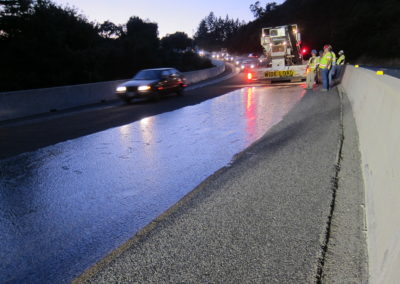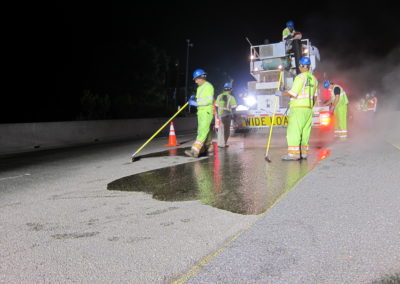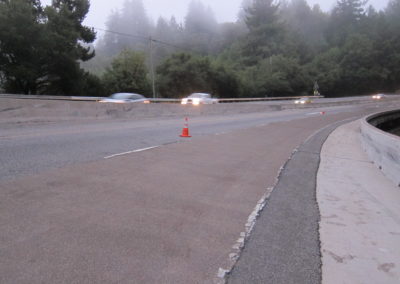Location:
Santa Cruz, CA
Owner:
California Department of Transportation
Project Completion:
2012
Project Details
High Friction Surface Treatment (HFST) is routinely used to restore and increase friction in critical areas that are prone to crashes. On Highway 17 near Santa Cruz, CA, one such dangerous area exists, nicknamed the “deadly” Laurel Road Curve. This installation utilized Kwik Bond’s Polyester Polymer HFST resin with a broadcast of Calcined Bauxite aggregate. Two courses were installed because the asphalt pavement was an open graded friction course (OGFC). PPC HFST is designed to increase friction on the roadway surface and minimize crashes.
FACT:
60,000
Average Daily Traffic
Project Background
California State Route 17 is a mountainous 4 lane roadway which serves 60,000 vehicles per day. Due to the frequent wet weather conditions and the speed at which vehicles travel, there are frequent accidents near the intersection of Laurel Road and Route 17, believed to be due to vehicles losing traction and sliding into the median barrier.
Because of the high number of crashes, this curve had gained the attention of Caltrans, who wanted to try something new to make this area more safe. In conjunction with the Federal Highway Administration (FHWA), Caltrans decided to take part in a nationwide test utilizing High Friction Surface Treatment on the dangerous curve.
The Solution
First, the asphalt surface must be prepared. Any oil, paint markings or other material which may inhibit the resin from penetrating the asphalt and compromise the ability to bond must be removed. The area is then blown off with compressed air to remove any loose particles remaining on the surface.
Next, the polyester polymer resin was mixed in an automated truck and spread using notched squeegees. Shortly after spreading the resin, Calcined Bauxite is spread over the surface. These aggregates are very hard and resistant to abrasion and polishing. After the resin had cured, the excess aggregate is swept up and a second course was placed.
On this application, night time temperatures dropped to 50°F with fog and high humidity during the installation. With the Kwik Bond Polymers PPC HFST system, the polymer can be adjusted for cure rate and returned to traffic in less than 2 hours. Other polymer binder systems have slower cure rates and a limited temperature range for installation. The ability to adjust cure rates has proven to be highly advantageous when variable temperature ranges exist within the required installation window. Due to the high volume of traffic in this area, the local officials we very pleased with the short time in which they were able to return traffic, just 2 hours after final placement.
Lasting Success
Caltrans and the FHWA were very happy with the increase in friction and the accelerated rate in which the road was returned to traffic. Final friction numbers were substantially higher than with the OGFC and to date no crashes have been reported.
Previously crashes happened nearly every time it rained. Around 50 crashes were reported last year according the Caltrans officials.


